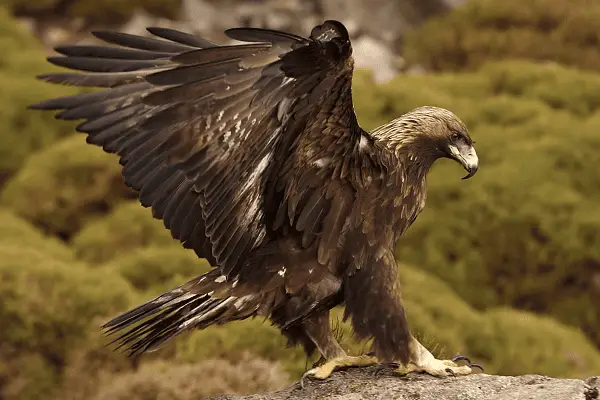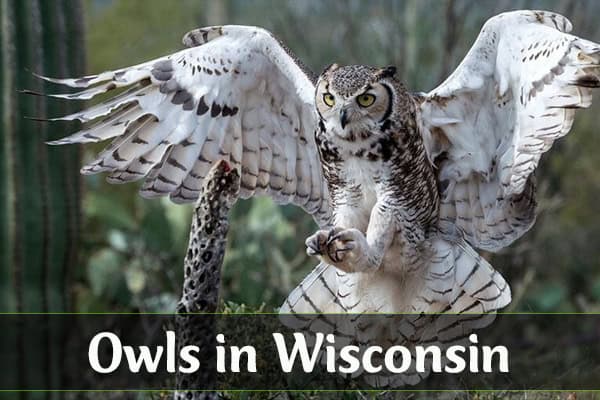2 Types of Eagles Found in Texas! (ID Guide)
Texas is home to two amazing eagle species – the bald eagle and the golden eagle. These birds are symbols of the United States. They can be seen all over Texas. But, they have different traits, ways of nesting, and how they hunt. Let’s dive into the world of eagles in Texas and learn about the types of eagles in Texas.
Introduction to Eagles in Texas
Texas is lucky to have two amazing eagle species – the bald eagle and the golden eagle. These birds are symbols of national pride and are key to the state’s diverse ecosystem.
1. Bald Eagle
- Scientific name: Haliaeetus leucocephalus
- Life span: 20-30 years
- Size: 2.5 to 3 feet
- Weight: 6.6 to 13,8 lbs
- Wingspan: 66 to 96 in
The bald eagle is more common in Texas. It has a white head and tail. You can see them all year, but more in winter.

Before 1972, there were fewer than 400 breeding pairs in the lower 48 states. But, thanks to the ban on DDT, their numbers have soared. Now, over 10,000 pairs live in the U.S. In Texas, their numbers grew from 18 to 156 from 1982 to 2005. They live in 76 counties, mostly in the eastern part of the state, near rivers and coastlines.
2. Golden Eagle
- Scientific name: Aquila chrysaetos
- Life span: 30 years
- Size: 33 inches
- Weight: 6.4 to 13.2 lb
- Wingspan: 70 to 90 in
Golden eagles are less common but just as stunning. They are smaller than bald eagles and used to be more common in the East. Now, they’re mostly in the west. They stand out with their golden-brown feathers and strong hunting skills.

Learning about the bald and golden eagles in Texas helps us value these birds more. It also helps us work towards protecting them.
Nesting Behavior of Eagles in Texas
The nesting habits of bald and golden eagles in Texas are quite interesting. Bald eagles build their big nests in tall trees near water. This gives them a great view and easy access to fish, their main food. These nests can be huge, up to 10 feet wide and 4 feet deep, weighing as much as 1,000 pounds.
Research shows that bald eagles in Texas eat a mix of birds, reptiles, and fish. They mainly eat American coots, softshell turtles, and freshwater catfish. They eat more reptiles than any other group in North America.
Golden eagles in Texas make their nests on cliff ledges or in tall trees. They like to be in open areas where they can easily see and catch their food. Their nests can be up to 6 feet wide and 3 feet deep, strong enough for several adult eagles.
| Nesting Behavior | Bald Eagles | Golden Eagles |
|---|---|---|
| Nest Location | Tall trees near the water | Cliff ledges or tall trees near open habitats |
| Nest Size | Up to 10 feet wide, 4 feet deep, 1,000 pounds | Up to 6 feet wide, 3 feet deep |
| Diet | Birds (33.7%), reptiles (30.7%), fish (30.1%) | Wide range of prey, including small mammals, birds, and reptiles |
Bald eagles in Texas live in many counties like Angelina, Austin, and Bastrop. Their numbers have grown a lot, from 13 nests in 1982 to 117 in 2003. Over 80% of their nests raise young, and more than 70% of the young eagles make it their first year.
Both bald and golden eagles in Texas show how adaptable and diverse they are. Their nesting habits are key to understanding how to protect them. This knowledge helps in keeping these amazing birds safe in Texas.
Diet and Hunting Strategies of Eagles in Texas
Bald Eagle Diet
Bald eagles in Texas love to eat fish, which is their main food. They can spot fish from far away and catch them with their strong talons. They also eat small mammals, birds, and sometimes even carrion.
Back in the 18th century, there were 300,000 to 500,000 bald eagles in the USA. But, their numbers dropped in the 20th century because of hunting and DDT. Thanks to a DDT ban in 1972, their numbers are now around 300,000 again.
Read Our Previous Articles:
Golden Eagle Hunting
Golden eagles in Texas are great hunters. They lay 1-3 eggs in late winter or early spring. Their nests can be huge, up to 6 feet wide and 4 feet deep.
These eagles are amazing at hunting, succeeding about 20% of the time in Idaho. They need about 230 to 250 grams of food daily. They can go hungry for up to a week, eating a lot when they find food.
Golden eagles have very strong talons, able to lift more than their own weight. They use many hunting techniques and eat a wide variety of food, from 1.4 to 11.2 different species.
| Characteristic | Bald Eagle | Golden Eagle |
|---|---|---|
| Primary Food Source | Fish | Diverse prey, including small mammals and birds |
| Hunting Technique | Spot prey from a distance, swoop down and snatch with talons | Employ a variety of hunting strategies, with a success rate around 20% |
| Nesting Behavior | Not provided | Typically lay 1-3 eggs per clutch, build large nests up to 6 feet across |
| Lifespan | Not provided | Up to 30 years |
| Talon Strength | Not provided | Up to 750 pounds per square inch, can lift more than their own body weight |
Eagles in Texas: Conservation Efforts
The bald eagle population in Texas has made a big comeback. In the 1960s, they were in danger because of the pesticide DDT. But, thanks to a ban on DDT and conservation work, there are now over 150 active nests in Texas.
The bald eagle was listed as endangered in 1978 and then less threatened in 1995. From 1975 to 1995, the number of nests grew from 7 to 40. This shows how well conservation has worked. The Mid-Winter Survey counted 360 eagles in 1994, but numbers dropped to 248 by 1996.
The Texas Parks and Wildlife Department does important surveys on bald eagles. These surveys help track their numbers and support conservation. They are key to understanding how well the bald eagle is doing.
In 2007, the bald eagle was taken off the endangered list. This was a big win for conservation. The DDT ban in 1972 was a key moment. Now, more people know about eagles and help protect them.
Conservationists and scientists keep working hard to protect bald eagles. They watch over their homes and study them. The bald eagle’s story shows how conservation can make a big difference.
While bald eagles are doing well, golden eagles in Texas still need our help. We must keep their homes safe, watch over them, and teach others about their importance. This will help both eagle species thrive in Texas.
Wrapping Up …
Texas is a great place for eagle fans, with both the bald eagle and the golden eagle living here. These birds are amazing, with big wings and a royal look. They are also great hunters.
The bald eagle was once in danger but now there are over 10,000 pairs in the U.S. and 150 in Texas. The golden eagle is harder to see but can be found in western Texas. These eagles show how important it is to protect nature.
If you love Texas eagle watching or just enjoy nature, you’ll be amazed by the bald eagle and golden eagle of Texas. Next time you see them, remember to appreciate their strength and beauty. Let’s all help protect these incredible birds.







